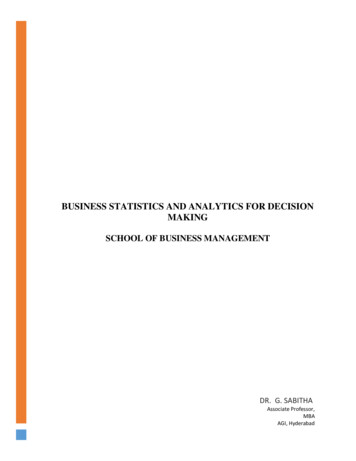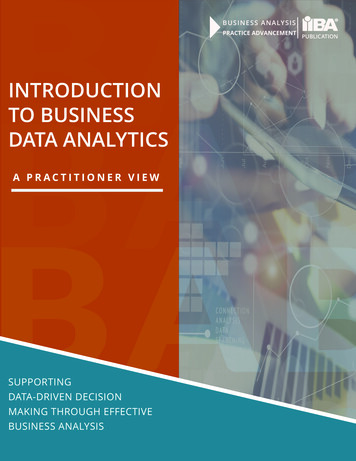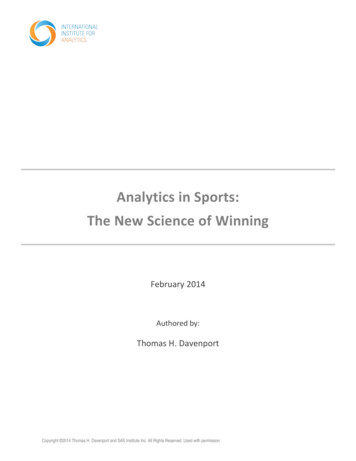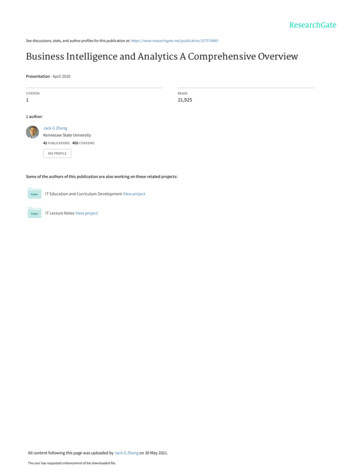
Transcription
BUSINESS STATISTICS AND ANALYTICS FOR DECISIONMAKINGSCHOOL OF BUSINESS MANAGEMENTDR. G. SABITHAAssociate Professor,MBAAGI, Hyderabad
Course File IndexS.No.Item DescriptionPageNumber1Course Information Sheet1-22Syllabus3Text Books, Reference Book, Web/Other Resources4Programme Educational Objectives(PEO’s)65Programme Outcomes(PO’s)76Bloom’s Taxonomy87Course Outcomes(CO’s), Mapping & Articulation Matrix98Course Schedule10-119Lecture Plan11-1210Minutes of Course Review Meeting11Unit Wise Questions14-1712Case Study18-2113Previous Question Papers2114Tutorial Sheet2215Course Assessment Report2316Direct Assessment Sheet2417CSP Rubric Name & Number2418Indirect Course Assessment Sheet2519Add-ons , PPT’s & Lecture Notes2634-5132
Anurag Group of InstitutionsSchool of Business ManagementCourse Name: Business Statistics and Analytics for Decision MakingCourse Number: A93002Course DesignationCredits: Core: 4I MBA – I Semester(2019-20)Name of FacultyAcademicYear/RegulationDr. G. Sabitha2019-20/R183
SYLLABUSUnit – IUnit – IIUnit – IIISampling: Primary Data and Secondary Data Collection Techniques, Questionnaire Design.Tabulation of data and general rules of Tabulation. Diagrammatic and Graphical presentation ofdata.Measures of Central Tendency: Measures of Dispersion, Measures of Skewness andInterpretation, Correlation and Regression Analysis, Method of Least squares. Types ofCorrelation and their specific applications.Statistical Inference: Introduction to Null hypothesis , Alternative Hypothesis, Tests ofHypothesis, Procedure for Testing of Hypothesis, Tests of significance for small samples,Application, t-Test, ANOVA – One Way and Two Way Classifications with BusinessApplications.Unit – IVChi-square test, Association of Attributes and Inferences: Parametric- Parametric vs. NonParametric, Sign Test, Sign Rank Test, Run Test, Median test, McNemar's Test, Kruskal-WallisTest with Business Applications.Unit – VTime series: Utility of Time Series, Components, Business Applications, Measurement of Trendthrough Method of Least Squares, Moving averages, and Graphical methods, Measurement ofSeasonal variations.4
Text Books1Donald R. Cooper, Pamela S. Schindler: Business Research Methods, TMH, 8/e, 20092Gaur, Statistical Methods for Practice and Research, Sage Publication,2009Reference BooksBhandarkar& Wilkinson, Methodology and Techniques of Social Research, Himalaya, 2009123Bajpai, Business Statistics, Pearson, 2009Richard I Levin & David S.Rubin, Statistics for Management, Pearson, 7/e, 20085
MBA PROGRAM EDUCATIONAL OBJECTIVES (PEO’s):1. To teach the fundamentals of the key elements of a business organization.2. To provide a critical perspective on theoretical knowledge and practical approach tovarious functional areas of management and decision making.3. To develop analytical skills to identify the link between the management practices in thefunctional areas of an organization and business environment.4. To establish and realize a creative research culture among the student community.5. To provide insights on latest technology, business communication, management conceptsand to build team work and leadership skills within them.6. To inculcate the habit of inquisitiveness and creativeness aimed at self-actualization andrealization of ethical practices.PROGRAM LEARNING OUTCOMES (PO’s):The learning outcomes specify the knowledge, skills, values and attitudes students are expected to attainin courses or in a program.1. Business Environment and Domain Knowledge: Graduates are able to improve their awarenesssand knowledge about functioning of local and global business environment and society.2. Critical thinking, Business Analysis, Problem Solving and Innovative Solutions: Graduates areexpected to develop skills on analysing the business data, application of relevant analysis, andproblem solving in other functional areas such as marketing, business strategy and humanresources.3. Global Exposure and Cross-Cultural Understanding: Demonstrate a global outlook with theability to identify aspects of the global business and Cross Cultural Understanding.6
4. Social Responsiveness and Ethics: Graduates are expected to identify the contemporary socialproblems, exploring the opportunities for social entrepreneurship, designing business solutionsand demonstrate ethical standards in organizational decision making.5. Effective Communication: Graduates are expected to develop effective oral and writtencommunication especially in business applications, with the use of appropriate technology.6. Leadership and Teamwork: Graduates are expected to collaborate and lead teams acrossorganizational boundaries and demonstrate leadership qualities, maximize the usage of diverseskills of team members in the related context.Course Objective: To enable students to analyze & apply various Statistical Techniques forBusiness Decision MakingCourse Outcomes: At the end of the course the students able to1. Demonstrate the Collection & Presentation skills of Data2. Solve the problems related to Correlation & Regression Analysis3. Apply relevant techniques for solving problems.4. Make use of Parametric & Non-Parametric Techniques for Problem Solving.5. Apply Time Series & Other measure for Analyzing Trends.7
DefinitionsBloom’sDefinitionI. RememberingExhibit memoryof previouslylearned materialby recalling facts,terms, basicconcepts, andanswers.II. UnderstandingDemonstrateunderstandingof facts andideas vingdescriptions,and statingmain ideas.III. ApplyingSolve problemsto new situationsby applyingacquiredknowledge, facts,techniques andrules in adifferent way.IV. AnalyzingExamine andbreakinformation intoparts byidentifyingmotives orcauses. Makeinferences andfind evidence tosupportgeneralizations.V. EvaluatingPresent anddefendopinions bymakingjudgmentsaboutinformation,validity ofideas, orquality ofwork based ona set ofcriteria.VI. CreatingCompileinformationtogether ina differentway bycombiningelements ina newpattern orproposingalternativesolutions.Verbs eTranslate tifyInterviewMake use nspectListMotiveRelationshipsSimplifySurveyTake part inTest forTheme veRateRecommendRule InventMake ctProposeSolutionSolveSupposeTestTheory
MAPPING OF COURSE OUT COMES WITH PO’s & ,52,3,4,6Articulation matrix of Course outcomes with PO’sProgram Educational ObjectivesProgram OutcomesPO 1PO 2PO 3PO 4PO 5CO123--2CO223--2CO323--2CO423--2CO523--2PO 6PEO 1PEO 2PEO 3PEO 4PEO 5PEO 6-22-3-2--323-2--323-2--323-2--323-29
Course ScheduleDistribution of Hours in Unit – WiseUnitTopicChaptersTotal No.of 2: 1,2,8RB3: 2,6TB1: 3,7,8,9TB2:19,20RB1:18RB2: 3,4,14,15RB3: 3,12,13TB1: 2,4,5,6TB2:18RB1:18RB2: 9,10,11,12,13RB3: 8,9,11IIntroductionIIMeasures of Central TendencyIIIStatistical InferenceIVParametric Vs Non-parametricRB1:9,11,12,18,26RB2: 18RB3: 1410Time SeriesRB1:9,11,12,18,26RB2: 16RB3: 1512VTotal classes for Syllabus coverageIncluding Tutorial Classes (1 per week)TB1: Text Book 1; TB2: Text Book 2RB1: Reference Book 1 and so onOther suggested books:1. SC Gupta, Indra Gupta, Business Statistics, Himalaya Publishing, 2007.2. Sharma, Business Statistics, Pearson, 20093. J K Sachdev, Business Research methodology, Himalaya Publishing, 2009.1012141361
Lecture PlanS.No.No ofLectureHoursTopicTeaching Learning ProcessUNIT-1: Introduction1Introduction to Business, Statistics Analysisand Decision Making, Importance12Sampling1Chalk & Board31Case study4Primary and Secondary Data CollectionTechniquesQuestionnaire Design1Practical5Tutorial (Questionnaire Collection)1Assignment6Tabulation of Data and General Rules2Problems7Diagrammatic Representation of Data2Activity using Excel8Graphical Representation of Data2Activity using Excel9Tutorial (Representation of Data)1AssignmentTotal Class hours required for Unit 112Chalk & Board1UNIT-2: Measures of Central TendencyMeasure of Dispersion2Problems2Measures of Skewness and ial1Assignment5Regression3Problems6Methods of Least Squares3Problems7Tutorial1Case studyTotal Class hours required for Unit 2141UNIT-3: Statistical InferenceHypothesis tests and Procedures1Chalk & Board2T- Test2Problems3ANOVA-One Way2Problems4Tutorial1Case Study11
5ANOVA-Two Way3Problems6Chi Square Tests3Problems7Tutorial1Case StudyTotal Class hours required for Unit 313Unit-4: Parametric Vs Non-ParametricSign Test11Problems2Sign Rank Test1Problems3Run Test2Problems4Tutorial1Case Study5Median Test1Problems6Mc’Nemar’s Test1Problems7Kruskal-Wallis Test2Problems8Tutorial1Case StudyTotal Class hours required for Unit 4102Utility of Time Series,Business ApplicationsMethod of Least Squares31Unit-5: Time SeriesComponents,1Chalk & Board3ProblemsMoving Averages2Problems4Tutorial1Case Study5Measurement of Seasonal Variation4Problems6Tutorial1Case StudyTotal Class hours required for Unit 512Total contact classes for Syllabus coverage : 6112
Minutes of Course Review MeetingDetails of Meeting No Date of MeetingMember’s PresentSignature ofMember’sRemarksDetails of Meeting No Date of MeetingMember’s PresentSignature ofMember’sRemarksDetails of Meeting No Date of MeetingMember’s PresentSignature ofMember’sRemarks13
Unit-1Short questions:1.2.3.4.5.6.Explain the concept of Statistics (L2, CO1)Explain Primary Data (L2, CO1)Explain Secondary Data (L2, CO1)Briefly explain the principles of Classification (L2, CO1)Discuss the Frequency Distribution. (L2, CO1)A College Management wanted to give scholarships to MBA students securing 70% and abovemarks. The marks of 25 students who were eligible for scholarship are:74,62,84,52,62,75,85,67,80,55, 58, 67,74,81,65,78,82,78,56,58,76,73,55,58,68. Monthlyscholarships are:%of MarksMonthlyScholarship(in 00Calculate the monthly scholarship paid to the students. (L6, CO1)7. The weekly observations on cost of living index in a certain city for the year 2018-19 are givenbelow:Cost of living Index: 140-150 150-160160-170170-180No. of workers:5102098. Prepare ‘less than’ and ‘more than’ cumulative frequency distributions. (L6, CO1)9. Discuss the discrete variable and continuous variables with 4 examples each. (L4,CO1)10. Explain briefly about the Types of Questions. (L3, CO1)Long questions:1. If you are appointed to conduct a statistical enquiry, describe in general what steps will you betaking from the stage of appointment till the presentation of your report. (L5, CO1)2. Distinguish between Primary and Secondary data and discuss the various methods of collectingPrimary Data. (L3, CO1)3. What are the essentials of a good questionnaire? Draft a suitable questionnaire to enable you tostudy the effects of super markets on prices of essential consumer goods. (L6, CO1)4. Discuss the Origin and Development of Statistics. (L2, CO1)5. Problems on presenting the given data in tabular form (L6, CO1)6. What are the considerations to be taken into account in the construction of a table? Construct atable showing the profits of a company for a period of 5 years with imaginary figures? (L5, CO1)14
7. Describe the advantages of diagrammatic representation of statistical data. Name the differenttypes of diagrams commonly used and mention the situations where the use of each type ofdiagram would be appropriate. (L4, CO1)8. Problems on presenting the data in diagrams. (L6, CO1)Unit-2:Short questions:1. List out various measures of Dispersion. Also Discuss the Absolute and Relative Measure (L2,CO2)2. Short problems on various measures of Dispersion. (L6, CO2)3. Explain the concept of negative and positive skewness. (L2, CO2)4. Short Problems on skewness. (L6, CO2)5. Discuss the different methods of Correlation. (L2, CO2)6. Problems on Correlation. (L6, CO2)7. Explain the concept of Regression and point out its usefulness in dealing with business problems.(L2, CO2)8. Problems related equation of regression. (L6, CO2)9. Problems on Correlation Coefficient. (L6, CO2)Long questions:1.2.3.4.5.6.7.Problems on various measures of Dispersion. (L6, CO2)Problems on skewness. (L6, CO2)Problems on Correlation. (L6, CO2)Problems related equation of regression. (L6, CO2)Comment on “regression Equations are irreversible”Distinguish between Correlation and Regression. (L2, CO2)Explain the terms: (i) Coefficient of Non-determination and (ii) Coefficient of Alienation andgive their physical interpretation8. Discuss the statistical validity of the following statements: (a) “High Positive coefficientCorrelation between increase in the sale of a newspaper and increase in the number of crimes,leads to the conclusion that newspaper reading may be responsible for the increase in the numberof crimes” (b). “A high positive value of ‘r’ between the increase in cigarette smoking andincrease in lung cancer establishes that cigarette smoking is responsible for lung cancer” (L6,CO2)9. Elucidate “Average, dispersion, skewness and kurtosis used in connection with the frequencydistribution of a continuous distribution” (L6,CO6)Unit-3:Short questions:15
1.2.3.4.5.6.7.8.Explain how hypothesis testing is important (L2, CO3)Establish null and alternative hypotheses about a population parameter (L6, CO3)Develop hypothesis testing methodology for accepting or rejecting null hypothesis (L6, CO3)Discuss the Type I and Type II errors and its implications in making a decision (L3, CO3)Interpret the confidence level, the significance level and the power of a test. (L6, CO3)Discuss the advantages and disadvantages of non-parametric statistical tests. (L2, CO3)Discuss ‘ANOVA’ for equality of three or more population means (L2, CO3)Summarize F-ration in the form of an ‘ANOVA’ table (L3, CO3)Long questions:1.2.3.4.5.6.7.8.Problems on t-test. (L6, CO2)Problems on z test. (L6, CO2)Problems on F test. (L6, CO2)Problems on computation of p-values. (L6, CO2)Problems on test significant association between categorical variables. (L6, CO3)Problems on ‘ANOVA’ one way (L6, CO3)Problems on ‘ANOVA’ two way (L6, CO3)Discuss how F distribution related to the student’s t distribution and the chi-square distribution?(L3, CO3)9. Discuss the components of total variation when samples are selected in blocks. (L3, CO3)Unit-4:Short questions:1.2.3.4.5.6.Discuss the Sign test with a business application (L4, CO4)Discuss the Sign Rank Test with a business application (L4, CO4)Discuss the Run Test with a business application (L4, CO4)Discuss the Median Test with a business application (L4, CO4)Discuss the McNemar’s test with a business application (L4, CO4)Discuss the Kruskal-Wallis Test with a business application (L4, CO4)Long questions:1.2.3.4.5.6.Problems on the Sign test (L6, CO4)Problems on Sign Rank Test (L6, CO4)Problems on Run Test (L6, CO4)Problems on Median Test (L6, CO4)Problems on McNemar’s test (L6, CO4)Problems on Kruskal-Wallis Test (L6, CO4)16
Unit-5:Short questions:1.2.3.4.5.6.7.8.Explain the judgmental forecasting model and when it is appropriate (L2, CO4)What is the advantage of reducing a time series into its four components?What are the advantages and disadvantages of trend analysis (L2, CO4)Under what circumstances can a trend equation be used to forecast a value in a series in thefuture. Explain. (L2, CO4)Problem on simple average method (L6, CO4)Problems on Time Series Analysis (L6, CO4)Problems on Moving Averages (L6, CO4)Problems on trend line method (L6, CO4)Long questions:1. Identify the classical components of a time series and indicate how each is accounting forforecasting (L4, CO4)2. Problems on Time Series Analysis (L6, CO4)3. Problems on Moving Averages (L6, CO4)4. Problems on trend line method (L6, CO4)5. Distinguish between trend, seasonal variations and cyclical variations in a time-series, how cantrend be isolated from variations? (L3, CO4)6. Explain the methods of fitting for the quadratic and exponential curves. How would you use thefitted curves fir forecasting. (L3, CO4)17
ANURAG GROUP OF INSTITUTIONS(Formerly CVSR college of Engineering)Venkatapur (v), Ghatkesar (M), R.R. Dist.Sub: Business Statistics and Analytics for Decision MakingModel Question paperSection AAnswer all the followingEach carries 5 marks1.2.3.4.5.Discuss the various methods of Sampling Techniques.Explain the different types correlationsDifferentiate Null Hypothesis and Alternative HypothesisDistinguish between Parametric and Non-Parametric testsDiscuss the methods of measurement of seasonal variationsSection BAnswer the following6. a) Design a questionnaire to survey the interest of the students in attending the value addedcourses which are not part of the curriculum.(OR)b) Represent the collected data of qn 6(i) in diagram and graphical method?7. a) Problem on Regression analysis.(OR)b) Problem on methods of least squares8. a) Discuss the application methods of ANOVA one-way and two-way.(OR)b) Problem on Chi square9. a) Problem on Parametric tests.(OR)b) Problem on Non-parametric tests.10. a) Problem on Moving averages(OR)b) Write a short note on (a) Time Series (b) Least Squares (c) Graphical methods18
Case studies:Unit 1: Introduction:Data from any official website will be given and ask the students to present it in diagrammatic andgraphical representation and interpret.Unit 2: Measures of Central Tendency:i.Case Study Researchers explored the crying of infants four to ten days old and their IQ testscores at age three to determine if more crying was a sign of higher IQ.ii.Case Study Researchers explore Linear Regression And Correlation Analysis Of WaterQuality Parameters of any project/ villageUnit 3: Statistical Inference:i.For demonstrating the power of chi-square test we use cross tabulations (Table B.7) fromopen source book (technical report): http://fas.org/sgp/library/spies.pdfProblemWe want to estimate association between the job occupied (civilian, military) andthe source of recruitment (volunteer, intelligence, family) that is declared strong by theauthor of this book. In fact this table can be used as is for chi-square test but we willuse chisq.test and barplot R-functions to prove or reject this hypothesis.ii.The Elementary Statistics for Medical Students (ESMS) projectThis project aims to strengthen the statistical skills for Medical students in Vietnam. Weprovide the problem-based tutorials, each one will show the student how to resolve a studyquestion using the appropriate methods. We focus on the basic statistical methods andcommon tasks All tutorials will be based on R, not only because this is a great tool for datavisualization and analysis, but also for encouraging the students to use a free softwareinstead of using the pirated packages like SPSS or Medcalc. Through these tutorials youwill realize that R is much more powerful than any commercial package you ever know.IntroductionThe one-way analysis of variance (ANOVA) is an omnibus statistical method for verifyingwhether statistically significant differences exist between the means of independent groups.It worth to mention that the ANOVA is based on a linear model (LM), so our true intentionis to evaluate the “effect” of a multi-levels factor on the outcome. Further analysis such aspairwise comparison or planned contrast would also be required for verifying ourhypothesis, because stand alone ANOVA cannot locate which specific groups werestatistically significantly different from each other.This tutorial will show you how to carry out an One-way ANOVA in R. We also suggestsome popular techniques for pairwise comparison, including Tukey post-hoc test,Bonferroni adjustment and planned contrast analysis. Last but not least, we also introduce19
some bootstraping procedures for ANOVA and post-hoc test, as well as how to interpretand report the results.ContextIn this parrallel group clinical trial, 606 patients were randomized into 4 treatment groups(A,B,C and D). Each group was treated with a different dose of drug X (A lowest,D highest). All patients underwent a liver function test before and after the treatment. Theoutcomes include Alkaline phosphatase, Alanine aminotransferase, Aspartateaminotransferase and Total bilirubin levels. For this tutorial we will only focus on the Totalbilirubin level (TBL). Our study question is whether the drug doses have an effect on posttreatment TBL level?Unit 4: Parametric and Non-Parametric Test:Statistical Comparisons by Means of Non-Parametric Tests: A Case Study onGenetic Based Machine LearningUnit 5: Time Series:Manufacturing Case Study ExamplePower Horse, a tractor and farm equipment manufacturing company, was established a fewyears after World War II. The company has shown a consistent growth in its revenue fromtractor sales since its inception. However, over the years the company has struggled to keepit’s inventory and production cost down because of variability in sales and tractor demand.The management at Power Horse is under enormous pressure from the shareholders andboard to reduce the production cost. Additionally, they are also interested in understandingthe impact of their marketing and farmer connects efforts towards overall sales. In the sameeffort, they have hired you as a data science and predictive analytics consultant.Investigate this problemACTIVITIES: Discussions/presentations onUnit 1: Introduction: Asking the students to collect online survey toolsA situation will be given to prepare a questionnaireGraphical method using ExcelUnit 2: Measures of Central Tendency: An analysis on correlation using a CaseAn analysis on Regression using a CaseUnit 3: Statistical Inference: An analysis using Chi-square, ANOVA one-way and Two-way20
Unit 4: Parametric and Non-Parametric Test: Study on Non-Parametric testUnit 5: Time Series: Time Series, Moving averages analysis of official data collected fromGovt. websites.Tutorial SheetUnit-I Topics RevisedTopic NamePreparation of a QuestionnaireDiagrammatic and Graphical representation of a dataUnit-I Topics RevisedTopic NameCorrelation and RegressionMethods of Least SqauresUnit-III Topics RevisedTopic NameANOVA two wayChi SqaureUnit-IV Topics RevisedTopic NameRevision of Sign, Rank Sign test and Run testRevision of Median, McNemar’s and Kruskal-Wallis TestsUnit-V Topics RevisedTopic Name21
Time Series and Moving AveragesCourse Assessment ReportBatch:Academic Year/Sem:Course Name:Course Number:Course Attainment (75% of Direct 25% of Indirect) on a scale of 1 to 3.Remarks and suggestions:Course Coordinator22
Direct Course Assessment Sheet (As per IonCudos)a) Internal ExaminationCourse assessment sheet Ass1Hall Ticket No123S1S2TOTCourse assessment sheet rse assessment sheet Ass2Hall Ticket No123S1S2TOTCourse assessment sheet Mid2HallTicketNo123S1S2S3S4S5b) External Examination23L1L2L3L4
Hall Ticket NoTotal MarksCSP Rubric24
S.No. Criteria LEVEL ( Level: 3-ExcellentOralCommunicationWriting Skills3Social andEthicalAwareness3ContentKnowledge453 Student uses appropriate methods, techniques to model and solve theproblem accurately2 Student tries to model the problem but fails to solve the problem1 Student fails to model the problem and also fails to solve the problem3 Listens carefully to the class and tries to answer questions confidentlyListens carefully to the lecture but doesn’t attempt to answer the2questions212121 Student makes no attempt in identifying the societal and ethical issues1 Student neither listens to the class nor attempts to answer the questionsManagerial skills362PracticalKnowledge17Student speaks in phase with the given topic confidently using AudioVisual aids. Vocabulary is goodStudent speaking without proper planning, fair usage of Audio-Visualaids. Vocabulary is not goodStudent speaks vaguely not in phase with the given topic. Nosynchronization among the talk and Visual AidsProper structuring of the document with relevant subtitles, readability ofdocument is high with correct use of grammar. Work is genuine and notpublished anywhere elseInformation is gathered without continuity of topic, sentences were notframed properly. Few topics are copied from other documentsInformation gathered was not relevant to the given task, vaguecollection of sentences. Content is copied from other documentsStudent identifies most potential ethical or societal issues and tries toprovide solutions for them discussing with peersStudent identifies the societal and ethical issues but fails to provide anysolutions discussing with peers323Level: 1-Poor)StudentParticipation1Level: 2-Good321The program structure is well organized with appropriate use oftechnologies and methodology. Code is easy to read and welldocumented. Student is able to implement the algorithm producingaccurate resultsProgram structure is well organized with appropriate use oftechnologies and methodology. Code is quite difficult to read and notproperly documented. Student is able to implement the algorithmproviding accurate results.Program structure is not well organized with mistakes in usage ofappropriate technologies and methodology. Code is difficult to read andstudent is not able to execute the programIndependently able to write programs to strengthen the conceptscovered in theoryIndependently able to write programs but not able to strengthen theconcepts learned in theoryNot able to write programs and not able to strengthen the conceptslearned in theory25
Understandingof Engineeringcore8Student uses appropriate methods, techniques to model and solve theproblem accurately in the context of multidisciplinary projectsStudent tries to model the problem but fails to solve the problem in the2context of multidisciplinary projectsStudent fails to model the problem and also fails to solve the problem in1the context of multidisciplinary projects326
Indirect Course Assessment SheetTools:a) Case StudyS.No.Hall Ticket NumberRubric Assessment123b) Course End Survey ReportAdd-ons (Guest Lecture/Video Lecture/Certification/Training Program/PosterPresentation . etc. )1. Poster Presentation2. Rank Sheet CertificationUnit Wise PPT’s & Lecture Notes27
-----*********----28
BUSINESS STATISTICS AND ANALYTICS FOR DECISION MAKING SCHOOL OF BUSINESS MANAGEMENT DR. G. SABITHA Associate Professor, MBA AGI, Hyderabad . 2 Course File Index S.No. Item Description Page Number 1 Course Information Sheet 1-2 2 Syllabus 3 3 Text Books, Referenc











